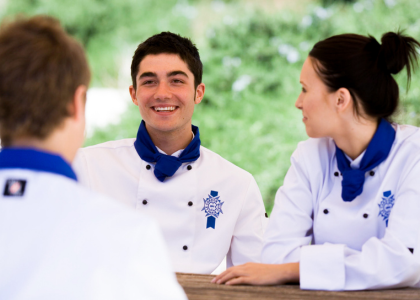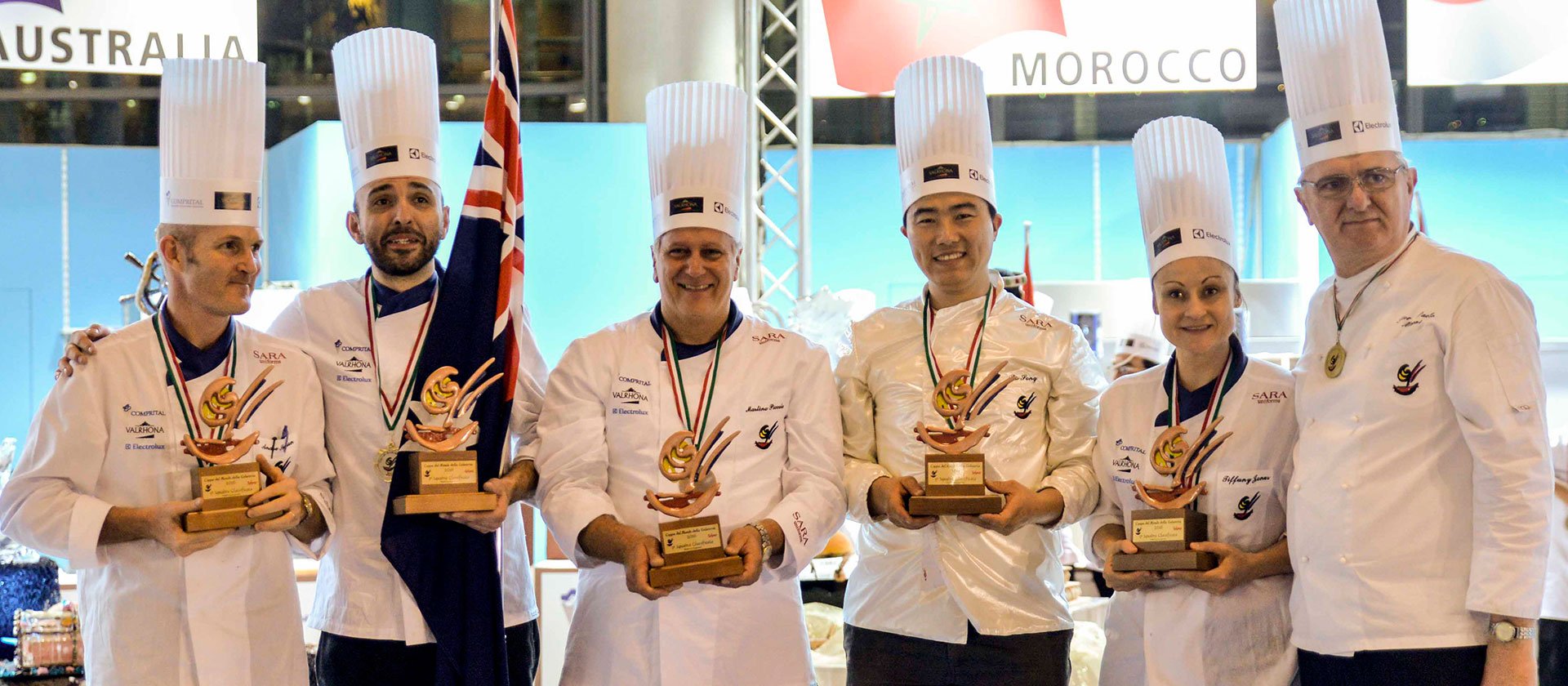
Le Cordon Bleu Adelaide announces new three-day training model
Le Cordon Bleu Adelaide is excited to announce a major shift in the way its Vocational Education and Training (VET) programs are delivered. In 2026, students ...
 Attracting over 200,000 people, including over 41,000 from abroad, Rimini’s 2016 edition of Sigep was an international event of epic proportions. During the expo, the Australian gelato team did their country proud, with a podium finish in the biennial Gelato World Cup.
Attracting over 200,000 people, including over 41,000 from abroad, Rimini’s 2016 edition of Sigep was an international event of epic proportions. During the expo, the Australian gelato team did their country proud, with a podium finish in the biennial Gelato World Cup.
Lying on the Adriatic Coast, in the region of Emilia Romagna, the beachside city of Rimini is a tourist hotspot come summer. Its wide sandy beaches, buzzing nightlife and celebrated cuisine attract droves of tourists as the heat draws in. But in winter, it is a slightly different story. The rows of colourful umbrellas disappear and the beaches are pretty much deserted. Hotels that were filled to capacity just months prior have plenty of vacancies, the streets are quiet and many of the restaurants are almost empty. That is, until Sigep comes to town.
Held from 23-27 January, this year marked the 37th edition of Sigep, the International Exhibition for the Artisan Production of Gelato, Pastry, Confectionary and Bakery.
More than 1000 companies congregated under the one roof at the Rimini Fiera expo centre to showcase their wares and over 500 events were held as part of Sigep.
Among the key events on the 2016 calendar was the Gelato World Cup, held every two years.
This year, Australia took part in the Gelato World Cup. After three days of fierce competition, the home of gelato, Italy, took out first place, followed by Spain in second place and then Australia, which finished in a very respectable third place.
Australia has certainly made a name for itself in the world of artisan gelato – particularly in Rimini – in recent times. In January 2014, Australian gelato maker, Martino Piccolo, finished on top in the ‘Mystery Box’ component of the Gelato World Cup, where competitors are required to develop a gelato using a mystery ingredient, which is then presented to the judging panel. Then in September that same year, an Australian gelato maker named John Crowl, who runs a local gelati shop called Cow and The Moon in Sydney, won the coveted title of ‘World’s Best Gelato’ for his Almond Affogato flavour during the inaugural Gelato World Tour grand finale, which was held in Rimini in front of a crowd of over 70,000 people.
Now, the Australian gelato team has followed this up with a podium finish at the prestigious Gelato World Cup – proving that Australians don’t necessarily need to travel all the way to Italy for an authentic, high quality gelato.
More and more Australian consumers are demanding top quality products, and gelaterias are responding by sourcing the highest quality ingredients they can get their hands on to produce their gelato the traditional Italian way. All over the nation, new gelaterias keep popping up, dishing out a level of quality they can be proud of.
There were 13 teams that took part in the seventh edition of the Gelato World Cup – Argentina, Australia, Japan, Italy, Morocco, Mexico, Poland, Spain, Switzerland, USA, Chile, Uruguay and Singapore.
Each team was required to present a series of seven components – a gelato cake, a decorated cup, a savoury entrée with gourmet gelato, a chocolate gelato mignon, a mystery box gelato, an ice sculpture and a final grand buffet.
Martino, who owns The Art of Gelato Michelangelo in Sydney, headed up the Australian team as team manager. He was joined by Gelato Messina head chef Donato Toce, Le Cordon Bleu Sydney head of pâtisserie Chef Andre Sandison, The Pastry Project chef Tiffany Jones and ice sculptor William Song.
Helping to guide the Australian team was owner of Gelato Messina, Nick Palumbo, who took on the role of technical assistant.
Martino worked closely with Peter Sutton from Oppenheimer Comprital to put the Australian team together. “There was a lot of behind the scenes work and Peter carried a lot of weight on his shoulders. He coordinated fundraising and did a lot of the administration too,” says Martino.
As the Gelato World Cup isn’t yet that well known in Australia, a regular selection process was out of the question. Instead, the duo handpicked their team, looking for the most skilled professionals they could find. “We chose these people because they were the best,” Martino says.
Ahead of the final, on the competition stage, Martino had told Italianicious that he was hopeful of a podium finish. And his wish came true, with only four points separating the team from second place getter, Spain.
“We’re ecstatic,” he proudly exclaims. “What we had achieved only really sunk in the next day. Third place might not seem like such a big deal but we are the first Australian team to hit the podium in any gelato competition in all of Europe. Australia wasn’t seen as a threat going into the competition but I knew all along that we were capable of a podium finish.”
The Australian team showed a high degree of professionalism, with everything planned down to a tee.
We had a grid with exact times for everything. It was all perfectly worked out so that we knew what temperature the gelato would be at every step of the process. And Nick Palumbo kept us in line throughout the competition,” Martino reveals. “What made us so strong is that everyone in the team was highly skilled so we could all cover for each other if needed.
This is the fourth time Martino has competed in the Gelato World Cup. He has been in the gelato industry for 30 years and says that he still discovers something new each time he visits Sigep. So he knew what was needed in order for Australia to be successful in the competition.
The Australian team spent three months working together and refining their theme ahead of the main event. Gelato ingredient manufacturer Oppenheimer Comprital – which along with F. Mayer Imports and the Property Investors Alliance (PIA) were the team’s platinum sponsors – invited the team to make use of their premises in Milan to train and undertake final preparations in the two weeks before the Gelato World Cup.
When we were practicing and training, we worked to make things better,” says Martino. “Repetition makes it easier. Because we did everything so many times, we were able to tackle any problem. We couldn’t have had a better team. Everyone worked really hard and was so focused.
Australia’s chosen theme was ‘Treasures of the Pacific’. A stunning mermaid ice sculpture, carved free hand by William Song, held the team’s ‘Pure Gold’ gelato cake that was presented inside a sugar and chocolate treasure chest. The decorated cup was created in the form of a pearl, that once cracked, revealed the gelato inside.
Another of Sigep’s key competitions for 2016 was the biennial Pastry Queen women’s world pastry championship. Italian pastry chef Silvia Federica Boldetti won the competition, with Japan’s Aki Tanimura and France’s Marléene Bachellerie forming the top three.
Italy also took top honours in the Star of Chocolate competition, with Italian chocolatier, Lorenzo Puca, winning the international chocolate competition; and the Italian team came first in the Bread in the City bread baking competition.
With this major international industry event over for another year, the industry can brace itself for another world-class event in 12 months time. Each edition of the enormous event that is Sigep seems to get bigger and bigger. And next year will be no exception. A current project will see even more exhibition space opened up for the 2017 event, before works are fully completed in 2018.
Copyright © 2025 Le Cordon Bleu International B.V. All Rights Reserved.